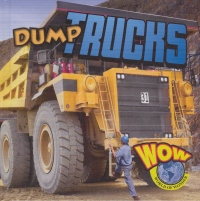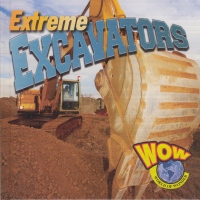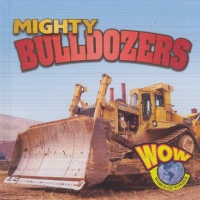| ________________
CM . . .
. Volume XVII Number 26. . . .March 11, 2011 
 |
Dump Trucks. (WOW: World of Wonder).
Blaine Wiseman.
New York, NY: Weigl (Distributed in Canada by Saunders Book Company), 2011.
24 pp., pbk. & hc., $10.95 (pbk.), $23.95 (hc.).
ISBN 978-1-61690-146-2 (pbk.), ISBN 978-1-61690-145-5 (hc.).
Subject Headings:
Dump trucks-Juvenile literature.
Grades 1-4 / Ages 6-9.
Review by Mary Thomas.
*** /4
|
| |
|
 |
Extreme Excavators. (WOW: World of Wonder).
Blaine Wiseman.
New York, NY: Weigl (Distributed in Canada by Saunders Book Company), 2011.
24 pp., pbk. & hc., $10.95 (pbk.), $23.95 (hc.).
ISBN 978-1-61690-134-9 (pbk.), ISBN 978-1-61690-133-2 (hc.).
Subject Heading:
Earthmoving machinery-Juvenile literature.
Grades 1-4 / Ages 6-9.
Review by Mary Thomas.
*** /4
|
| |
|
 |
Mighty Bulldozers. (WOW: World of Wonder).
Blaine Wiseman.
New York, NY: Weigl (Distributed in Canada by Saunders Book Company), 2011.
24 pp., pbk. & hc., $10.95 (pbk.), $23.95 (hc.).
ISBN 978-1-61690-143-1 (pbk.), ISBN 978-1-61690-142-41(hc.).
Subject Heading:
Bulldozers-Juvenile literature.
Grades 1-4 / Ages 6-9.
Review by Mary Thomas.
*** /4
|
| |
|

excerpts:
Backing Up
Have you ever used a mirror to look at the back of your head? Dump truck drivers use mirrors in much the same way. Mirrors on the side of the truck help the driver see the area behind the truck. However, there are still places the driver cannot see. Spotters are people who stand behind the truck and tell the driver if there are objects in the trucks's path.
Some spotters use flags or radios to signal the driver. Most use hand signals. The spotter points in a certain direction to show the driver which way to turn. Spotters slowly bring their hands together to tell the driver when to stop moving. (From Dump Trucks.)
Big Buckets
What are the world's biggest machines? Bucket-wheel excavators are the biggest land-based vehicles. They have several buckets on a spinning wheel at the end of the arm. These buckets can remove large amounts of material at once.
The biggest bucket-wheel excavator stands 312 feet (95 meters) tall. This big machine has 20 buckets. (From Extreme Excavators.)
There are six books in this series, and to judge from the three I looked at, they are all well designed, well bound, and colourfully illustrated volumes. Each book has twenty-four pages, each page of text having a full-page illustration opposite it. The pictures are captionless, and, in general, this is not a problem. Occasionally, this absence of text can be confusing as occurs when the picture accompanying the paragraph describing the three blades that might be attached to the front of a bulldozer does not indicate which of the three blades is actually shown.
Each page of text begins with a chapter heading and then a question to pique the reader's interest and to introduce the facts about to be presented. These two pieces of text are not always completely appropriate. Quoting from Extreme Excavators, on page 12, the chapter heading is, "Where Does It Go?" and the question is, "What makes excavator arms move?" This prefaces an explanation of hydraulic systems, but left me with the question "Just where does what go?" The oil of the hydraulics? The fuel (since "New, environmentally friendly systems use less fuel to power machines")? The exhaust? (since "less pollution is sent into the air in the form of exhaust?") On the whole, however, the headings and questions are, in fact, good lead-ins to the explanations which follow.
Hydraulics come into at least two of the books and are the subject of the small experiment/activity section at the end of Extreme Excavators. A schematic diagram, such as that found in the howstuffworks.com website (url supplied), might have been more helpful than the actual picture which showed a bit of an enormous piston glistening with oil. It could have had the additional advantage of showing how hydraulic systems can increase power output. Admittedly it would have made a less "WOW!" illustration.
Each book has a page suggesting an activity illustrative of the subject of the book. The bulldozers and dump truck books both give ideas of how to construct a toy machine out of ordinary materials, such as construction paper, egg cartons, and cardboard. These would be fun activities, and well within the capabilities of the targeted audience. The hydraulics experiment at the end of the excavator book requires a pair of syringes and a bit of rubber tubing, items not always readily available in your average household. Potentially, however, this experiment is a very useful way of explaining how such systems work.
A surprising amount of information can be packed into 24 small pages of simple text. The index and glossary would be some help to the student with specific enquiries about any of these huge machines, but, on the whole, the books will be pored over by young boys eager to be impressed. WOW is a very good acronym for the title of the series.
Recommended.
Mary Thomas works for the Winnipeg School Division in an elementary library and will be very surprised if these books are not in constant circulation.

To comment
on this title or this review, send mail to cm@umanitoba.ca.
Copyright © the Manitoba Library Association. Reproduction for personal
use is permitted only if this copyright notice is maintained. Any
other reproduction is prohibited without permission.
NEXT REVIEW |
TABLE OF CONTENTS FOR THIS ISSUE
- March 11, 2011.
AUTHORS |
TITLES |
MEDIA REVIEWS |
PROFILES |
BACK ISSUES |
SEARCH |
CMARCHIVE |
HOME |


